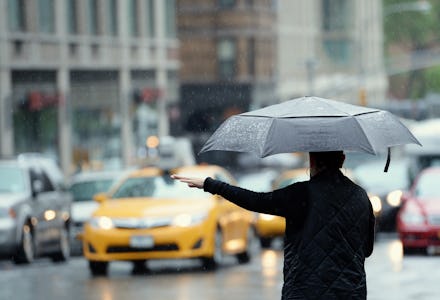What Uber Is Really Doing for the People It's Claiming to Help, in One Map

Working-class people in underserved communities need Uber — or, at least, that's what Uber's aggressive ad campaign is telling you.
The message: In cities like New York, the low-income population relies on the car-service app because cab drivers don't go where they go. For anyone sick of getting turned down for a lift due to race, ability or location, Uber is the reliable ride.
But does that claim actually hold up? A report from FiveThirtyEight shows that there's little to no difference between the class demographics of people who use cabs and people who use Uber. In fact, the report found, there's a nearly one-to-one correlation by neighborhood.
Meaning: Uber isn't servicing low-income neighborhoods of New York any better than cabs are.
The correlation between cab or Uber usage and household wealth in the map above is so striking that anyone familiar with New York City would look at that and think it was a heat map for real estate prices or, incidentally, areas where public transit in the city is the most readily available.
From the extensive FiveThirtyEight report (bolded selection ours):
But in New York overall, there isn't much difference between the people picked up by Uber and the ones who ride in cabs. Uber and taxis both disproportionately serve wealthy areas within Manhattan or just across the bridges and tunnels from it. What's more, these customers usually live in neighborhoods with abundant public transit access also. In other words, the combination of public transit and for-hire vehicles is something that New Yorkers have been relying on for years.
Taking a car in many major cities is a luxury — a way for the upper class to ferry themselves around a constrained few pristine neighborhoods, and a special treat for the rest of us to get home after a long night. Cabs are expensive, so cab drivers often congregate in wealthy neighborhoods, where they'll find the most potential passengers.
But Uber distances itself from that picture of upper-class bourgeois lifestyle. An app can send a car to a far-flung neighborhood if need be, and for what it's worth, Uber will claim that prices are going to get lower and lower. The company regularly runs promotions and slashes prices. Uber also has a carpooling service, UberPool, that offers cheaper fares to riders who share.
But that comes at a cost. Right now, these lower fares are possible because Uber's drivers are contract employees who have to put up with sudden and drastic changes to the way they're paid, leaving them ducking for cover when Uber needs to slash fares in its war against competitor Lyft. And eventually, Uber wants to replace all of those workers with an invisible army of robot drivers.
Uber CEO Travis Kalanick has even spent the past year teasing out his vision for never-ending trips that operate like a giant, flexible, privatized bus system.
"If you can get 10 people trips on this perpetual ride, this UberPool ride, and the driver needs to make 25 euro an hour, you're now looking at a situation where each person-trip costs 2 euro and 50 cents," Kalanick said at the Digital-Life-Design conference last October. "And that's sort of the vision of where Uber wants to go."
Uber could eventually bear out that dream of killing all car ownership and providing dirt-priced rides anywhere in America to anyone. But for now, it's still largely used by the wealthy in wealthy areas — a tool for everyone fed up with the old, clunky taxi system, who can afford to tap a button instead of wait on the corner for a cab.
The Uber Effect: When hot new apps disrupt old-fashioned services like laundry, taxicabs or public transportation, the people with the capital and influence to improve these systems (and investors) often lose interest in making those services better and opt instead to replace them with a corporate solution.
Uber may sap the public of the political will to fix the city's problems, and what's left is a class divide: increasingly worse services for those who can't afford to use an app, and luxury solutions for those who can.